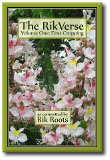Friday, September 16, 2005
Conbiology for beginners
It stands to reason that if you develop a fantasy world, and have people in the world speaking fantasy languages, then you'd want fantasy wildlife to go with it - man-eating triffids and the like.
Well, that's what this post is all about. I'm going to introduce you to a bit of Kaliedan biology. (Kalieda, for those who have not been paying attention, is my constructed world - the world where people speak my constructed language Gevey).
To make this a bit interesting, I'm going to introduce you to a species of "animal" that sort of looks a little bit like a monkey, and has 3 sexes.
So, how can a creature have 3 sexes? It's not easy to design, believe me. Especially when you start to think about triple strands of DNA (impossible) and genes that come in threes. That thought in particular is guaranteed to implode your brain if you think about it too much!
So instead, my monkeys stick to the regular sort of DNA-type genetic coding material, and cells divide into twos rather than threes. Nothing scary here.
The way I tackled the problem is to invoke something called alternation of generations, which happens a lot in plants. The terrestrial form of this phenomenon allows the generations to alternate between haploid forms (one set of chromosomes) and diploid forms (2 sets of chromosomes). This happens in Kalieda, and the lifeforms representing plants and insects follow this pattern - the diploid "plants" giving rise to the haploid "insects", which in turn mate and produce new diploid "plants".
Now bear with me. This is fun!
The normal form of alternation of generations wasn't good enough for my monkeys. Instead, I doubled the cycle. The haploid phase is reduced to single celled gametes (just like in humans), but the diploid phase alternates between mobile and sessile forms. And these forms are determined by genetics.
In terrestrial mammals, sex is determined by the sex chromosomes: XX gives you females and XY gives you males. During reproduction these chromosomes split in half so you get an X and another X from the female, and an X and a Y from the male. The offspring can be XX, XX, XY or XY.
Still with me?
So here goes. We have two types of monkey: a big, tough monkey that stays in one tree, and a smaller, more agile monkey that only comes to the tree to breed.
And we have the tree - its kind of shaped like a monkey, but it has leaves instead of hair and the bones are greatly elongated and the brain and sensory organs much degenerated. This is one form of the third sex (thopugh in fact it's assexual, in that its only purpose is to act as the brood chamber where that alternation of generation thingy happens).
So as not to confuse things, I'll call my monkey's sex chromosomes B and b - the breeder chromosome. When sex occurs, we get a mix of BB, Bb and bb - and each of these genotypes selects for a different sex.
Now the big monkey is BB and the little monkey is bb. The monkeytree is Bb. The little monkey visits the monkeytree and, after calming down the big monkey with presents of food, etc, has sex with the big monkey. The result of this mating is a sack of soft "seeds". Now because BB has mated with bb, all these seeds will be Bb. Two things can happen to these seeds.
The first thing is that the seeds can be laid in pouches within the monkeytree, where they are nurtured for a little while, turning into slug-type hermaphrodite Bb creatures which can breed with each other - these are the real third sex, though most people would assume the monkeytree itself was the third sex.
Now the results of breeding Bb with Bb will be 25% each of BB and bb, and 50% Bb. Let's discard these second generation Bb slugmonkeys - perhaps they develop much slower than the proper baby monkeys, who eat them as they grow within the monkeytree pouches. Soon enough the monkeytree gives birth to a new generation of miniature BB and bb monkeys, who grow up in the monkeytree until grandparent monkey drives them all off.
This is where option 2 for those Bb seeds comes in. Grandchild BB takes the Bb seed with (let's call it) her when she leaves the monkeytree. Now because this particular Bb seed never made it into the confines of the monkeytree's brood chamber, the brood chamber hormones have not been working on it, which means that once the young monkey finds a nice place, she can plant the seed and feed/guard it while it grows into a new brood tree.
I told you it would be fun! Maybe next week I'll post some sketches of my Kaliedan monkeys, if I can find time to do them.
Well, that's what this post is all about. I'm going to introduce you to a bit of Kaliedan biology. (Kalieda, for those who have not been paying attention, is my constructed world - the world where people speak my constructed language Gevey).
To make this a bit interesting, I'm going to introduce you to a species of "animal" that sort of looks a little bit like a monkey, and has 3 sexes.
So, how can a creature have 3 sexes? It's not easy to design, believe me. Especially when you start to think about triple strands of DNA (impossible) and genes that come in threes. That thought in particular is guaranteed to implode your brain if you think about it too much!
So instead, my monkeys stick to the regular sort of DNA-type genetic coding material, and cells divide into twos rather than threes. Nothing scary here.
The way I tackled the problem is to invoke something called alternation of generations, which happens a lot in plants. The terrestrial form of this phenomenon allows the generations to alternate between haploid forms (one set of chromosomes) and diploid forms (2 sets of chromosomes). This happens in Kalieda, and the lifeforms representing plants and insects follow this pattern - the diploid "plants" giving rise to the haploid "insects", which in turn mate and produce new diploid "plants".
Now bear with me. This is fun!
The normal form of alternation of generations wasn't good enough for my monkeys. Instead, I doubled the cycle. The haploid phase is reduced to single celled gametes (just like in humans), but the diploid phase alternates between mobile and sessile forms. And these forms are determined by genetics.
In terrestrial mammals, sex is determined by the sex chromosomes: XX gives you females and XY gives you males. During reproduction these chromosomes split in half so you get an X and another X from the female, and an X and a Y from the male. The offspring can be XX, XX, XY or XY.
Still with me?
So here goes. We have two types of monkey: a big, tough monkey that stays in one tree, and a smaller, more agile monkey that only comes to the tree to breed.
And we have the tree - its kind of shaped like a monkey, but it has leaves instead of hair and the bones are greatly elongated and the brain and sensory organs much degenerated. This is one form of the third sex (thopugh in fact it's assexual, in that its only purpose is to act as the brood chamber where that alternation of generation thingy happens).
So as not to confuse things, I'll call my monkey's sex chromosomes B and b - the breeder chromosome. When sex occurs, we get a mix of BB, Bb and bb - and each of these genotypes selects for a different sex.
Now the big monkey is BB and the little monkey is bb. The monkeytree is Bb. The little monkey visits the monkeytree and, after calming down the big monkey with presents of food, etc, has sex with the big monkey. The result of this mating is a sack of soft "seeds". Now because BB has mated with bb, all these seeds will be Bb. Two things can happen to these seeds.
The first thing is that the seeds can be laid in pouches within the monkeytree, where they are nurtured for a little while, turning into slug-type hermaphrodite Bb creatures which can breed with each other - these are the real third sex, though most people would assume the monkeytree itself was the third sex.
Now the results of breeding Bb with Bb will be 25% each of BB and bb, and 50% Bb. Let's discard these second generation Bb slugmonkeys - perhaps they develop much slower than the proper baby monkeys, who eat them as they grow within the monkeytree pouches. Soon enough the monkeytree gives birth to a new generation of miniature BB and bb monkeys, who grow up in the monkeytree until grandparent monkey drives them all off.
This is where option 2 for those Bb seeds comes in. Grandchild BB takes the Bb seed with (let's call it) her when she leaves the monkeytree. Now because this particular Bb seed never made it into the confines of the monkeytree's brood chamber, the brood chamber hormones have not been working on it, which means that once the young monkey finds a nice place, she can plant the seed and feed/guard it while it grows into a new brood tree.
I told you it would be fun! Maybe next week I'll post some sketches of my Kaliedan monkeys, if I can find time to do them.
Subscribe to:
Post Comments (Atom)










No comments:
Post a Comment